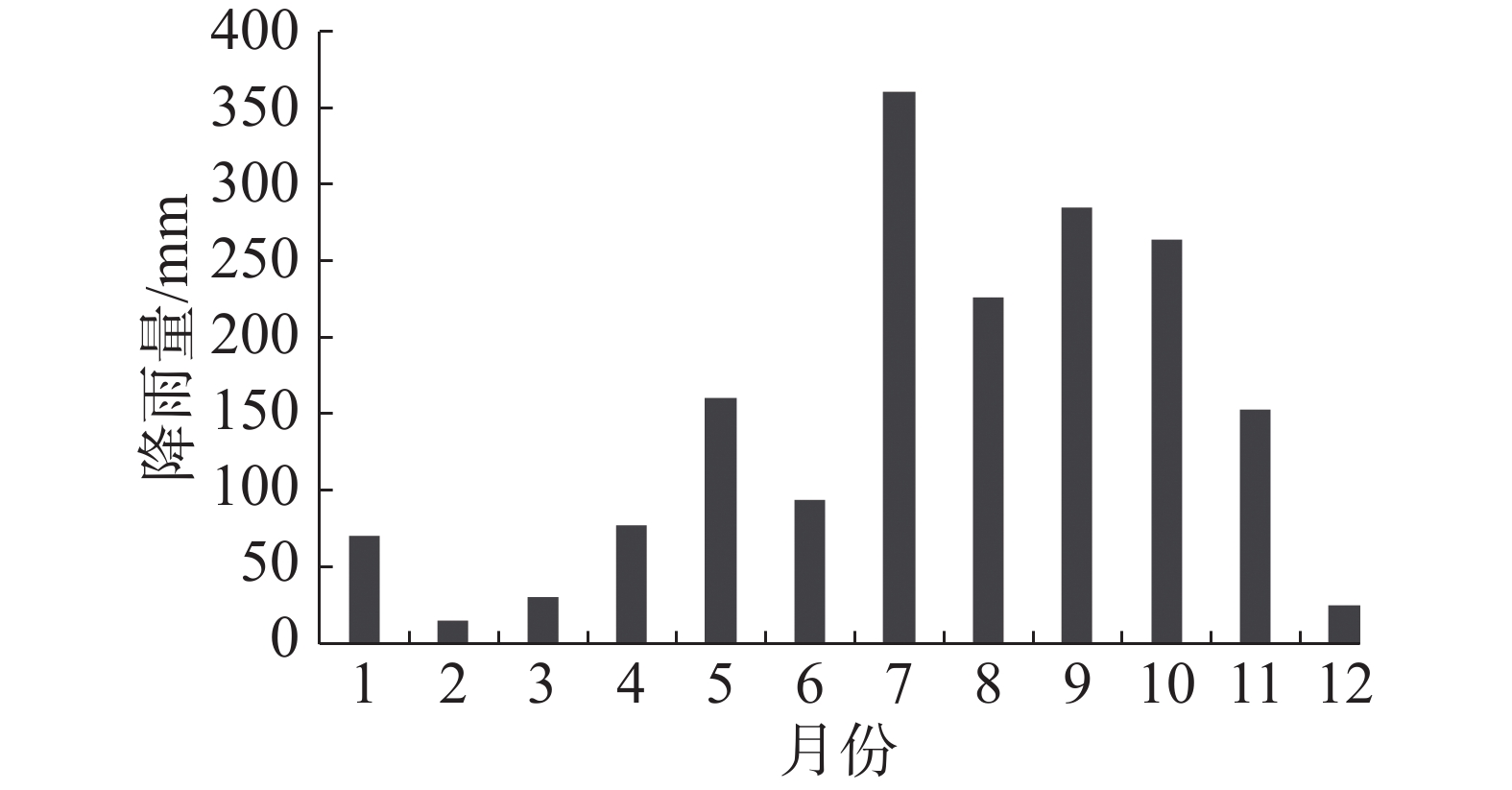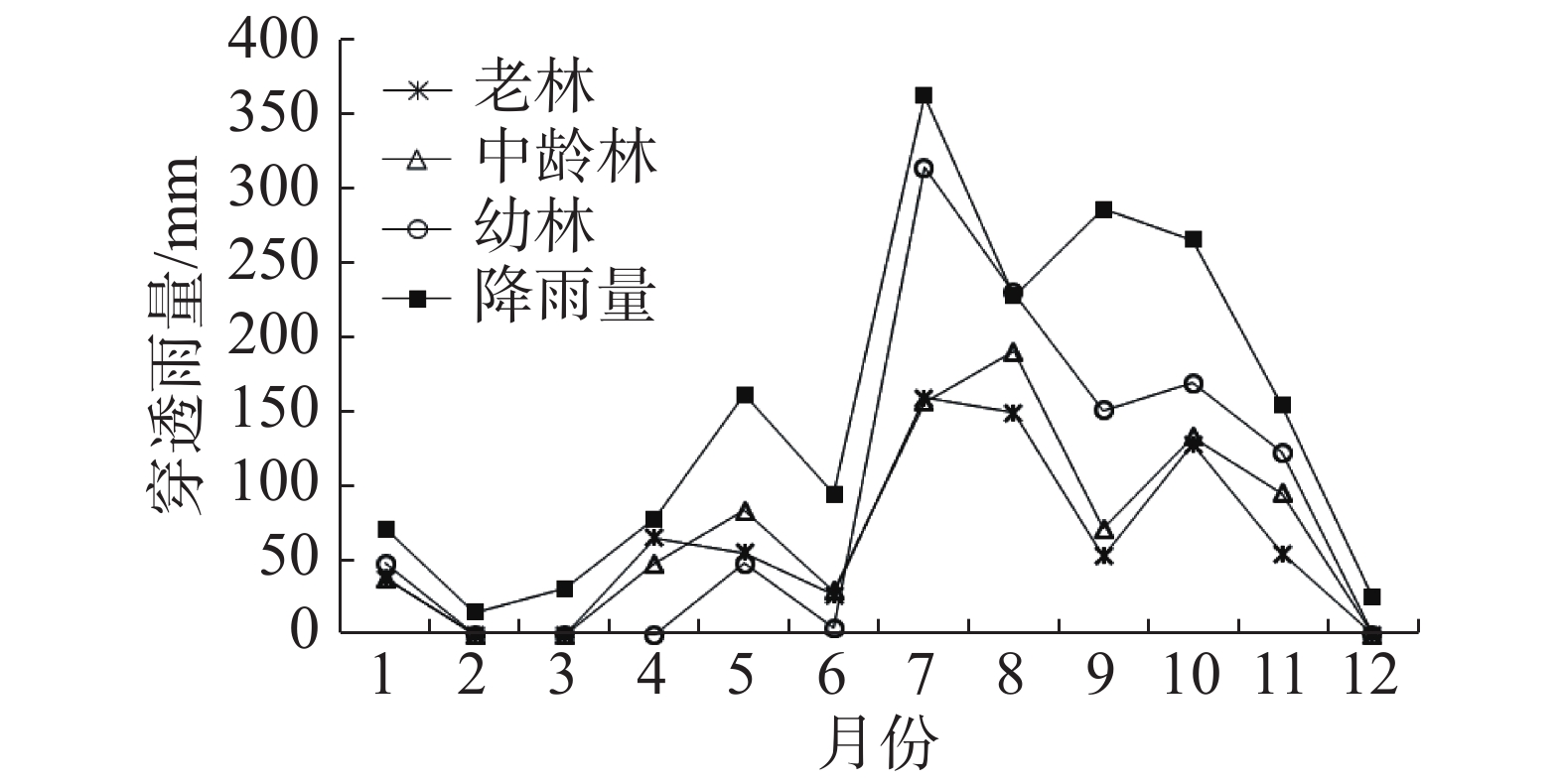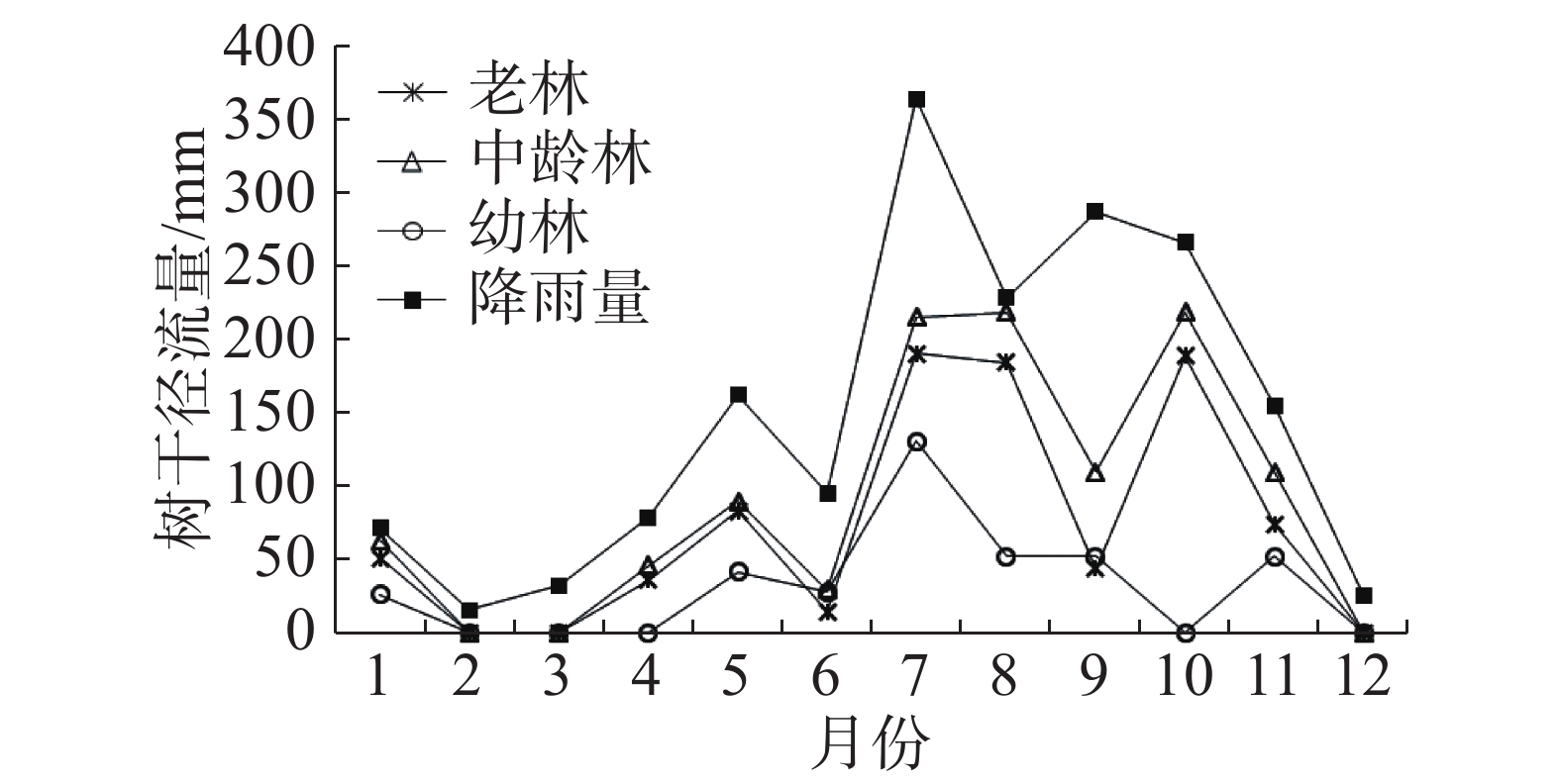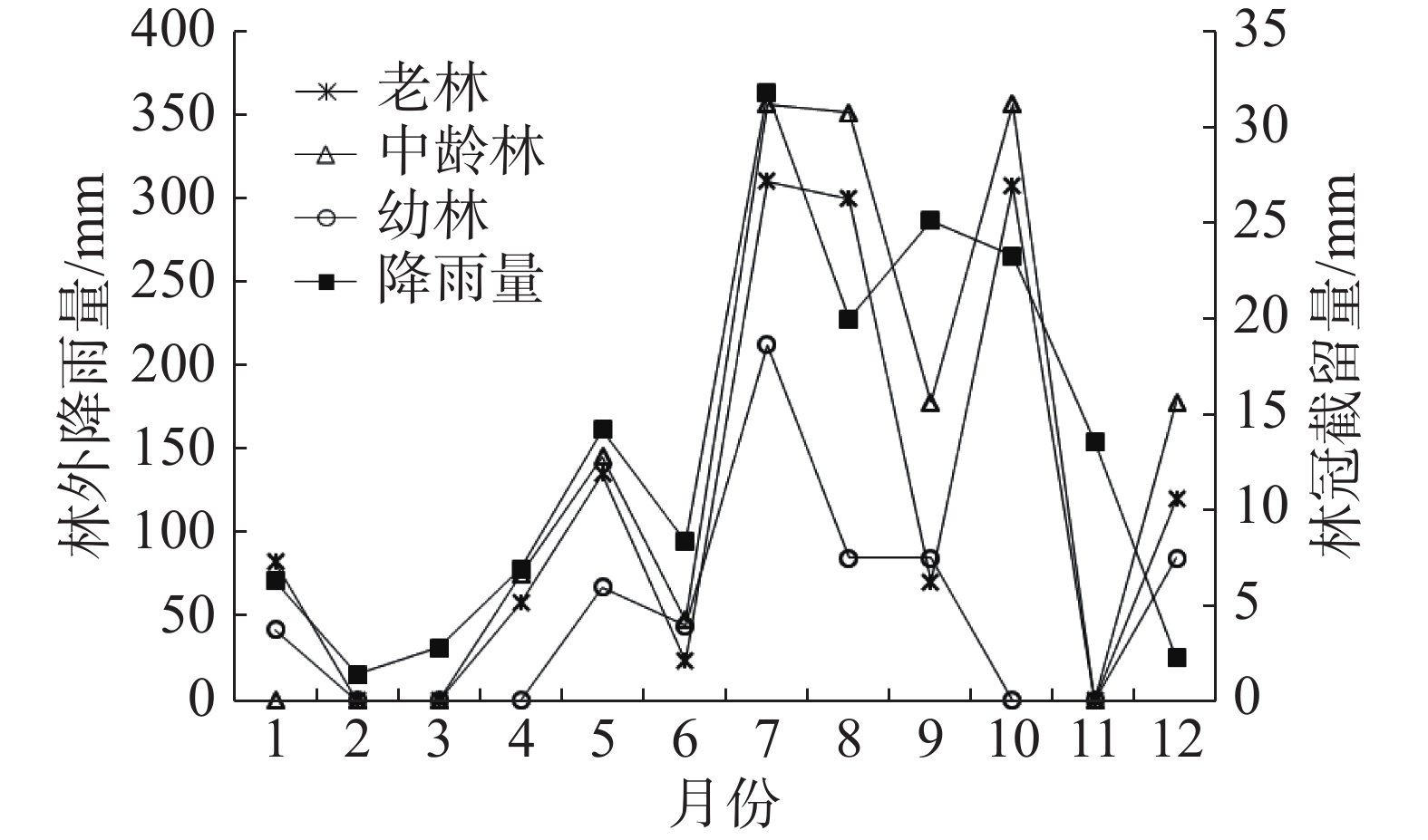-
云南西双版纳位于热带季风区北缘,气候高湿多雨,地形以山地为主。近几十年来,随着橡胶树(Hevea brasiliensis)种植面积的迅速扩张,西双版纳地区已成为我国最重要的橡胶树种植区之一,橡胶林已成为该地区最大的人工林生态系统,与热带季节雨林构成了该地区主要森林植被类型[1]。事实上,橡胶林与热带季节雨林是截然不同的两种森林类型。首先在群落结构方面,橡胶林是单层单种、结构简单的人工群落,而热带季节雨林是多层多种、结构复杂的自然群落;同时二者在生态功能方面也存在显著差异,如生物多样性水平、涵养水分能力、土壤质量状况等[2-5]。其中,单一大面积种植橡胶树是否会导致水土流失加剧,已成为近年来被广泛关注的问题之一。就此,研究人员对橡胶林的水土保持功能开展了多方面的观测研究工作,包括林冠水文效应方面[6-13]。林冠截留是森林水文效应研究的一项重要内容。不同森林类型由于其林分物种组成、群落层次结构以及植物叶、枝、茎持水特性的不同会导致其林冠水文效应有所差异[14-16]。橡胶树为高大乔木树种,主干明显且具较多分枝,三出指状复叶为椭圆或倒卵形革质小叶[6]。橡胶林是以橡胶树为唯一优势树种的单层林,林下植被覆盖较少,橡胶树冠层是发挥降雨截留作用的主体。大气降水通过橡胶林冠层时,部分雨水被树冠树叶截留;部分被截留的雨水沿着树叶转移到树枝,再从树枝转移到树干而流到橡胶林地,这部分雨水即为树干径流;还有部分雨水直接穿过冠层进入橡胶林地,即为穿透雨。由此,大气降水就被分配为穿透雨、树干径流和树冠截留3部分,同时可延长降雨达到林地的时间,削弱了雨水对林地的溅蚀和冲刷,有效减少水土流失[13,17-19]。此外,由于穿透雨可以把大气漂浮物、林冠截持物和淋溶物洗脱后输入到橡胶林地,而树干径流冲刷树干后会携大量营养物质集中到达橡胶树根部土壤,从而对土壤养分起到重要的补充作用[20 -23]。除了树叶、树枝、树皮及茎干特性等橡胶树自身因素之外,橡胶林的林冠截留时空分布格局也会受到树龄、种植方式、区域位置及气候气象等外部因素的显著影响[24-26]。因此,要全面准确地了解橡胶林的林冠水文效应状况,需要针对各种因素影响下的橡胶林开展大量而长期的观测研究工作。
本研究以西双版纳地区32 龄、12 龄、7龄 3个树龄阶段的橡胶林为研究对象,对其穿透雨量、树干径流量、林冠截留量以及林外降雨量进行全年观测,并对影响因素进行分析探讨,了解随树龄增长橡胶林林冠截留能力的变化特征,研究结果将为评估橡胶林的水文生态效应和制定科学种植管理措施提供基础依据,对促进天然橡胶产业可持续发展和维持区域水文生态安全也具有重要意义。
-
西双版纳傣族自治州(21°09′~22°40′N,99°55′~101°50′E)位于云南省最南端,地处北回归线以南的热带湿润区。全州面积19582.5 km2,海拔470~2 429.5 m,山地面积占95%。终年受西南季风影响,干湿季分明而四季不明显,有雾凉季(11~翌年1月)干热季(2~4月)和湿热季(5~10月)之分。年降水量1138.6~2431.5 mm,年均气温18.9~22.6 ℃,相对湿度60%~80%,为典型的热带季雨林气候[2,4,6,9]。
在云南省热带作物科学研究所江北橡胶林试验基地,选取32龄、12龄、7龄橡胶林样地,分别代表老龄林、中龄林、幼龄林3个不同年龄阶段的橡胶林,开展林冠截留特征研究。橡胶树均采用株行距3 m × 8 m的常规种植方式。由于云南省热带作物科学研究所橡胶林试验基地禁止使用除草剂;7龄和12龄橡胶林需在每年7月和11月各进行1次人工除草,控草高度在50 cm以下;32龄林无需进行除草管理。各样地基本情况见表1。
样地 海拔/m 定植年份 橡胶树
高度/m冠幅/m 茎围/cm 林分叶面积
指数林下常见植物 幼龄林 664 2010 8.33±0.21 5.67±0.47 43.44±0.27 1.82±0.09 禾本科的类芦(Neyraudia reynaudiana)、弓果黍(Cyrtococcum patens)、荩草(Arthraxon hispidus)、刚莠竹(Microstegium ciliatum)、白茅(Imperata cylindrica)、马唐(Digitaria sanguinalis)、竹叶草(Oplismenus compositus)、两耳草(Paspalum conjugatum),菊科的飞机草(Eupatorium odoratum)、蓝花野茼蒿(Crassocephalum rubens)、藿香蓟(Ageratum conyzoides)、鬼针草(Bidens pilosa)、假臭草(Praxelis clematidea)等,豆科的巨瓣豆(Centrosema pubescens)、葛藤(Argyreia seguinii),爵床科的肾苞草(Phaulopsis oppositifolia)、鳞花草(Lepidagathis incurva),梧桐科的粗毛刺果藤(Byttneria pilosa),马鞭草科的臭牡丹(Clerodendrum bungei),西番莲科的龙珠果(Passiflora foetida),葫芦科的红瓜(Coccinia grandis),含羞草科的无刺含羞草,鸭跖草科的竹节菜(Commelina diffusa),等 中龄林 632 2005 17.59±0.21 6.36±0.38 60.95±0.31 2.48±0.25 禾本科的弓果黍、竹叶草、皱叶狗尾草(Setaria plicata)、荩草,爵床科的肾苞草、鳞花草,莎草科的多脉莎草(Cyperus diffusus)、浆果薹草(Carex baccans),菊科的飞机草,海金沙科的柳叶海金沙(Lygodium salicifolium),豆科的镰瓣豆(Dysolobium grande),金虎尾科的盾翅藤(Aspidopterys glabriuscula),梧桐科的细齿山芝麻(Helicteres glabriuscula),楝科的鹧鸪花(Heynea trijuga),桑科的粗叶榕(Ficus hirta),卷柏科的攀援卷柏(Selaginella pseudopaleifera),以及蕨类植物剑叶凤尾蕨(Pteris ensiformis)、狭眼凤尾蕨(Pteris biaurita)、华南毛蕨(Cyclosorus parasiticus)、齿牙毛蕨(Cyclosorus dentatus),等 老龄林 840 1985 21.70±0.43 8.61±0.56 88.26±0.49 3.33±0.54 菊科的野茼蒿(Crassocephalum crepidioides)、蓝花野茼蒿、飞机草、藿香蓟、鬼针草、小蓬草(Conyza canadensis),禾本科的弓果黍、两耳草、皱叶狗尾草,防己科的细圆藤(Pericampylus glaucus),旋花科的掌叶鱼黄草(Merremia vitifolia),葫芦科的绞股蓝(Gynostemma pentaphyllum),爵床科的肾苞草,等 Table 1. Survey of sample plots
-
以安装在研究区域内高于林冠层的通量观测铁塔和小型自动气象站实时监测记录的降雨量数据作为该研究的林外降雨量数据,并收集空气温度、太阳辐射、阵风风速、空气湿度、大气压等气象因子数据。同时以西双版纳傣族自治州景洪市气象局所提供的在研究区域内的气象数据作为参考。
-
在3个林龄的橡胶林内各选择1块20 m × 20 m的样地,在样地内选取3株胸径、高度、冠幅中等的标准树,紧挨每株树沿顺坡向安装自制的“V”型穿透雨承接槽(上接面宽0.3 m,长4.5 m),槽离地高1 m。在承接槽上面铺1层防水材料防止锈蚀漏水,在出水口处垫一块纱网过滤枯枝落叶。用塑料软管将出水口与PVC集水桶连接,将承接槽收集到的穿透雨导入桶中。每次降雨后及时测量记录集水桶内的水量(Vt),根据承接槽的面积和集水桶收集到的穿透雨量换算出林内穿透雨量(mm)。
-
在以上3株标准树的树干距离地面1.3 m处,将聚乙烯薄板合围固定并密封严实,形成导流槽,在接口处剪一开口并连接一根软塑料管,将树干径流引入PVC集水桶中。每次降雨后及时测量记录集水桶内的水量(Vs),根据样地内橡胶株数和收集到的树干径流量换算出林分的树干径流量(mm)。
-
根据水平衡法计算不同林龄橡胶林的林冠截留量,计算公式如下:
式中,I为林冠截留量(mm),P为降雨量(mm),T为穿透雨量(mm),S为树干径流量(mm)。
橡胶林水平衡示意图见图1。
-
数据统计分析和绘图利用SPSS 17.0 和Microsoft Excel 2007完成。对各月及全年的林外降雨量、穿透雨量、树干径流量和林冠截留量进行统计绘图,采用回归分析和Spearman相关性分析探讨穿透雨量、树干径流量和林冠截留量与叶面积指数及气象因子的关系。
-
2017年观测的总林外降雨量为1773.7 mm,1~4月和12月降雨较少,月平均林外降雨量<100 mm;5~11月为雨季,降雨强度大,降雨量占当年总林外降雨量的87.48%(图2)。
-
幼林、中龄林、老林的年穿透雨量分别为1087.90、846.27、730.55 mm,分别占当年总林外降雨量的61.34%、47.71%和41.19%。不同月份间穿透雨量变化较大,以7月份的穿透雨量最大,幼林、中龄林、老林分别为314.11、190.32和159.47 mm,分别占其年穿透雨量的28.87%、22.48%和21.82%(图3)。从林龄角度看,穿透雨量呈现幼林>中龄林>老林的趋势。穿透雨量随着月降雨量的增大而增大,二者具有明显的线性相关关系,其回归方程分别为:幼林穿透雨(T)=11.789(P)+14.027,R2=0.160 2、中龄林穿透雨(T)=6.761(P)+26.571,R2=0.146 6、老林穿透雨(T)=4.636(P)+30.745,R2=0.087 9。
-
幼林、中龄林、老林的树干径流量分别为524、809.16、912.80 mm,分别占同期降雨量的29.54%、45.61%和51.46%。不同月份间树干径流量变化较大,以7月树干径流最大,幼林、中龄林、老林分别为127.46 mm、199.12 mm和226.58 mm,分别占其年树干径流量的24.32%、24.61%和24.82%(图4)。树干径流量随降雨量的增大而增大,具有明显的线性相关关系,其回归方程分别为:幼林树干径流量(S)=3.639(P)+20.05,R2=0.050 8;中龄林树干径流量(S)=8.6697(P)+11.076,R2=0.216 1;老林树干径流量(S)=9.6073(P)+13.619,R2=0.201 8。从林龄角度看,树干径流量呈现老林>中龄林>幼林的趋势。
-
幼林、中龄林、老林的年林冠截留量分别为54.37、147.57、123.04 mm,分别占林外降雨量的3.06%、8.32%、6.94%。不同月份间林冠截留量差异显著,以7月份截留量最大,幼林、中龄林、老林分别为18.57、31.14和27.12 mm、分别占其年截留量的34.15%、21.10%和22.04%。林冠截留量随降雨量的增大而增大,二者具有明显的线性相关关系,其回归方程分别为:幼林林冠截留量(S)=0.3411(P)+2.313,R²=0.051;中龄林林冠截留量(S)=1.804(P)+0.567,R²=0.263;老林林冠截留留(S)=1.042(P)+3.480,R²=0.124。从林龄角度看,林冠截留量呈现中林>老林>幼林的趋势(图5)。
-
对不同树龄橡胶林年穿透雨量、树干径流量及林冠截留量与其叶面积指数进行线性回归分析,结果表明,随着叶面积指数增大,穿透雨量呈减小趋势,树干径流量呈先升后降趋势,而林冠截留量呈增加趋势(图6)。
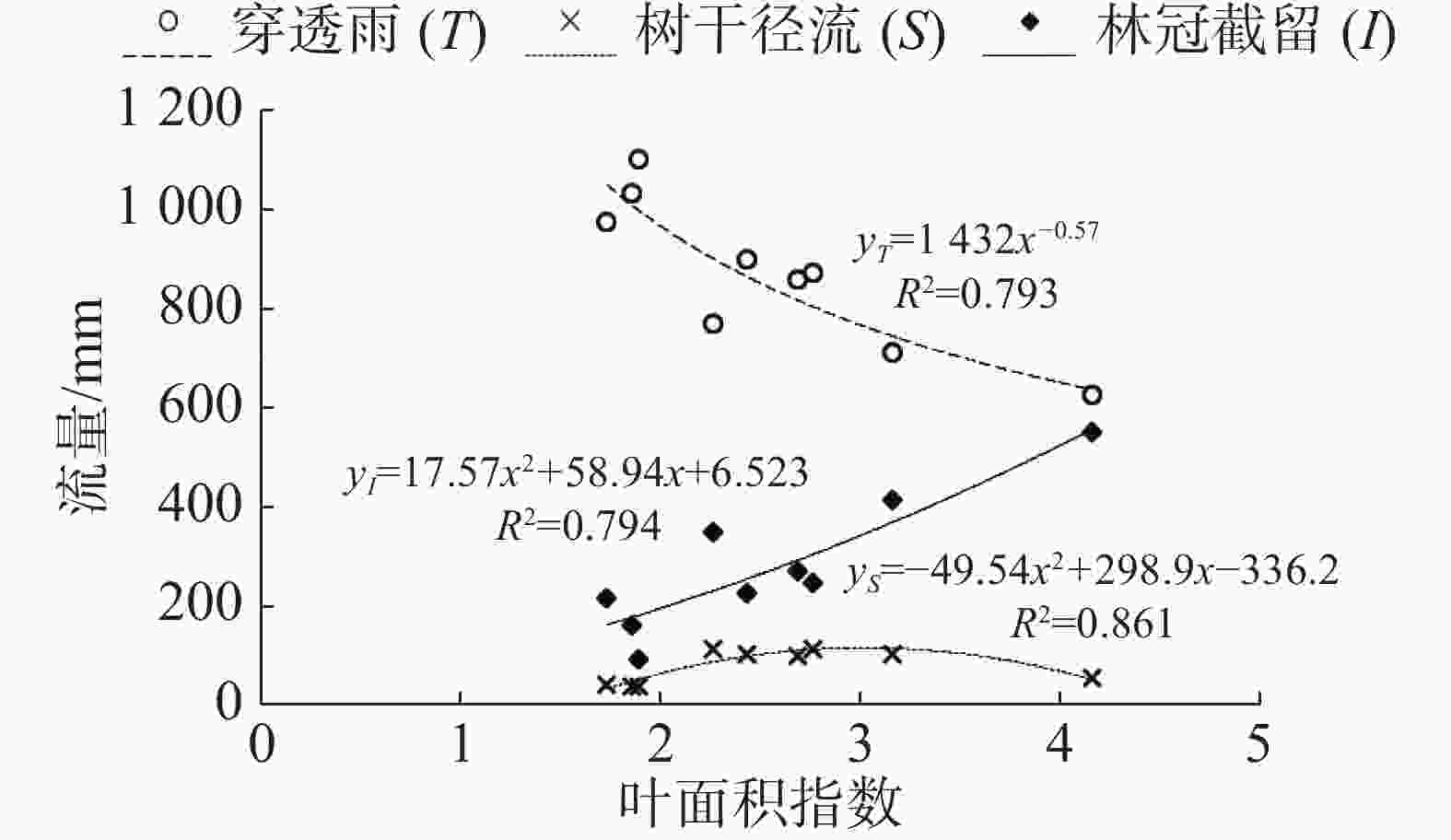
Figure 6. Correlations of annual throughfall, stemflow and canopy interception with leaf area index of rubber plantation
对橡胶林的月林冠截留量与月平均空气温度、太阳辐射量、风速、空气湿度、大气压和大气降水等气象因子进行非参数相关性检验分析表明,各林龄林地的林冠截留量与大气降水量呈极显著正相关(P<0.01),幼林的林冠截留量与空气温度也有一定相关性(P<0.05)(表1)。
林型 相关性 空气温度 太阳辐射 阵风风速 空气湿度 大气压 降水 Spe.相关系数 0.521 −0.345 −0.282 0.458 −0.049 0.761** 老林 Sig.(双侧) 0.082 0.272 0.375 0.135 0.879 0.004 N 12 12 12 12 12 12 Spe.相关系数 0.523 −0.364 −0.389 0.541 −0.011 0.767** 中龄林 Sig.(双侧) 0.081 0.245 0.212 0.070 0.974 0.004 N 12 12 12 12 12 12 Spe.相关系数 0.606* −0.095 −0.321 0.446 −0.132 0.577* 幼林 Sig.(双侧) 0.037 0.769 0.308 0.146 0.684 0.049 N 12 12 12 12 12 12 12 注:**. 在置信度(双测)为 0.01 时,相关性是显著的;*. 在置信度(双测)为 0.05 时,相关性是显著的。 Table 2. Correlations of monthly canopy interception of rubber plantation with meteorological factors
-
穿透雨是大气降水穿过橡胶林冠层直接输入林地内的水分,是橡胶林生态系统最主要的土壤水分来源。本研究结果表明,橡胶林的年穿透雨量为730.55~1087.9 mm,占同期总降雨量的41.19%~61.34%;穿透雨量随降雨量的增大而增大,其全年变化趋势与当地降雨的季相特征相一致,这也再次验证了已有研究表明的二者之间的线性正相关关系[25,27-28]。很多研究表明叶面积指数是影响橡胶林穿透雨量的一个重要因素[26,29-31],但也有研究认为叶面积指数对穿透雨分布的影响不明显[13]。该研究结果显示穿透雨量与叶面积指数总体呈负相关关系。随着林龄的增长,橡胶林的林冠郁闭度和叶面积指数增大,林冠截留能力增加,导致穿透雨量减少。同时,橡胶树种植方式不同,也会造成林冠郁闭度和冠层厚度的差异,进而导致穿透雨量的差异。本研究中30龄以上橡胶林的年穿透雨量小于张一平等的研究结果[29],可能与本研究采用的是常规种植方式(株行距3 m×8 m)而后者采用的是宽窄行密株的种植方式(株距3.1 m,窄行距2.5 m,宽行距19.0 m)有关。另外,穿透雨收集承接槽的表面积、风速、空气温度及湿度等因素,也可能影响穿透雨的收集。
树干径流是经过树叶、树枝、树干直接汇集到橡胶树根部土壤的水分,是橡胶树能够直接吸收利用的重要水分来源。已有研究表明,树种的叶片形状、树冠结构、枝条大小和数量、茎干高度和粗度、树皮吸水能力等树体特征均会对树干径流的形成产生明显影响。橡胶林的年平均树干径流量及其分配率(104.1 mm,6.18%)高于热带季节雨林(79.2 mm,5.15%)[29]。正是由于热带季节雨林有多物种多层次阻截降水,不易形成较大的树干径流;而橡胶林为单属种单冠层降水,且橡胶树叶片革质、叶柄长,树枝多,茎干长而粗,树皮光滑细腻不易吸水,较易形成树干径流。单就橡胶林来说,树龄不同,其树体大小和林冠截留能力存在差异,进而也会影响到树干径流的形成。该研究中,从橡胶树幼林到中龄林再到老林,年树干径流量呈现先增大后减小的抛物线形。分析认为,由于幼林叶面积指数和树冠较小,穿透雨多而树冠水分较少,从而形成的树干径流较小;中龄林的叶面积指数和树冠较大,树冠阻截水分增多,因此树干径流量变大;而老林的橡胶树茎干长而粗,径流到达根部土壤历时久历面宽,导致水分蒸发增多而收集到的树干径流量有所减少。此外,气象因素对树干径流量影响显著。树干径流量会随着降雨量的增大而增大,其全年变化特征与当地降雨的季相特征密切相关。
林冠截留是一个重要的水文影响过程,它不仅改变了输入输出橡胶林的雨量、时间和空间格局,也减弱了雨水对林地土壤的侵蚀,而林冠截留量与林冠特征、树体特性及气象因素等密切相关[8,26,30]。研究发现,热带季节雨林与橡胶林对降雨的林冠截留率(41.43%和24.68%)存在很大差异[29],这显然是由于二者的群落组成和林冠结构截然不同造成的。该研究和秦钟的研究[31]表明,7龄、12龄、21龄、32龄橡胶林对降雨的林冠截留率(分别为7.01%、13.27%、18.38%、30.49%)呈现逐渐增长趋势,说明林龄不同,橡胶林在林冠大小与厚度、叶片数量及叶面积指数大小等方面也有所不同,也会造成林冠截留率的显著差异。林冠截留还与降雨量呈显著正相关关系,此外还会受空气温度和空气湿度等气象的影响。但也有研究表明,一定范围内林冠截留量随降雨强度增大而增加,但降雨强度过大反而不利于雨水在枝叶表面停留[32]。总之,林冠截留是一个极为复杂的生态过程,多种因素可能均可能造成林冠截留的空间和时间特异性,因此需视不同情况具体分析。在不同地区、以不同角度或不同研究方法对橡胶林的林冠截留特征及其影响因素的进行研究,可不断丰富人们对橡胶林生态系统水文过程和水文效应的了解和认知,也可为橡胶林的科学种植管理提供重要的基础依据。
-
云南地形多以山地为主,做好水土保持是山地胶园种植管理工作的重中之重。橡胶林的林冠发挥着再分配降雨以及减缓水土流失的功能。该研究通过对西双版纳地区不同树龄橡胶林的穿透雨量、树干径流量、林冠截留量进行实际观测,了解了山地胶园的降雨再分配特征及其影响因素。研究结果说明,橡胶幼林树冠较小或未形成林冠,降雨会直接落到地面,冲刷地表,易产生水土流失;而随着林龄增长,橡胶树树冠逐渐增大,林冠截留水分能力增强,对降雨进行再分配的同时,也减缓了雨水对橡胶林地的溅蚀和冲刷。由此可见,亟需加强山地胶园的科学种植管理,针对不同地势和不同林龄阶段制定相应的水土保持措施。
Characteristics of rainfall redistribution of rubber plantations at different ages in Xishuangbanna
doi: 10.15886/j.cnki.rdswxb.2022.01.009
- Received Date: 2021-05-25
- Accepted Date: 2021-12-17
- Rev Recd Date: 2021-09-05
- Available Online: 2022-01-06
- Publish Date: 2022-01-31
-
Key words:
- rubber plantation /
- throughfall /
- stemflow /
- canopy interception /
- hydrologic effect
Abstract: Study on the canopy interception characteristics of rubber plantation can provide the basic information for rubber plantation management and regional hydro-ecology effect assessment. The rubber plantations at three age stages (young, 7 years old; middle, 12 years old; old, 32 years old) were selected for observation. The throughfall, stem flow, canopy interception of the rubber plantations at the three age stages were measured, and the effects of tree age, leaf area index and meteorological factors on the throughfall, stem flow and canopy interception were analyzed. The results showed that the annual throughfalls of the young, middle and old rubber plantations were 1087.90 mm, 846.27 mm and 730.55 mm, respectively, accounting for 61.34%, 47.71%, 41.19% of the annual precipitation. The annual stemflows were 524 mm, 809.16 mm and 912.80 mm, respectively, accounting for 29.54%, 45.61%, 51.46% of the annual precipitation. The annual canopy interceptions were 54.37 mm, 147.57 mm and 123.04 mm, respectively, accounting for 3.06%, 8.32% and 6.94% of the annual precipitation. In general, with the increase of tree age the throughfall decreased, while the stemflow and canopy interception increased. The leaf area index was inferred as the main factor affecting the difference of canopy interception between rubber plantations at different ages. Among the meteorological factors precipitation has the greatest impact on canopy interception.
| Citation: | ZHANG Yongbo, XIE Jiang, CHEN Guoyun, TIAN Yaohua, ZHOU Huiping. Characteristics of rainfall redistribution of rubber plantations at different ages in Xishuangbanna[J]. Journal of Tropical Biology, 2022, 13(1): 57-63. doi: 10.15886/j.cnki.rdswxb.2022.01.009 |


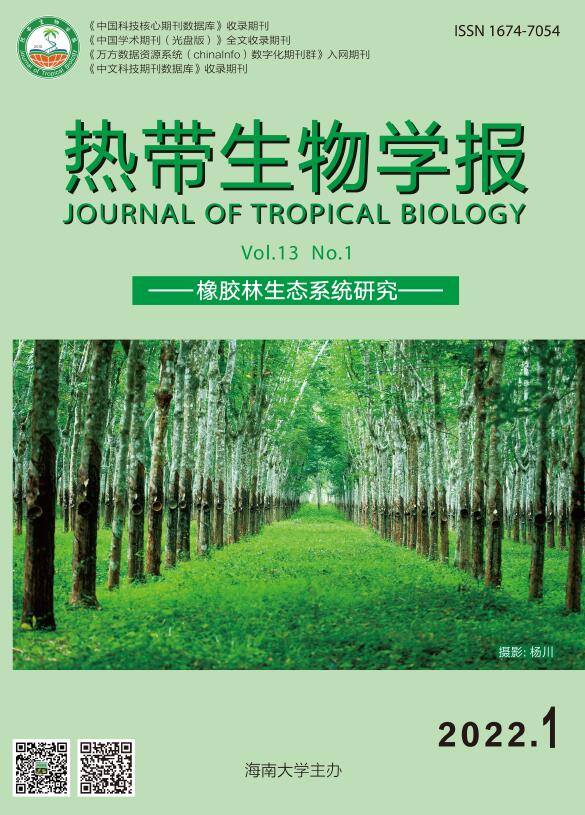


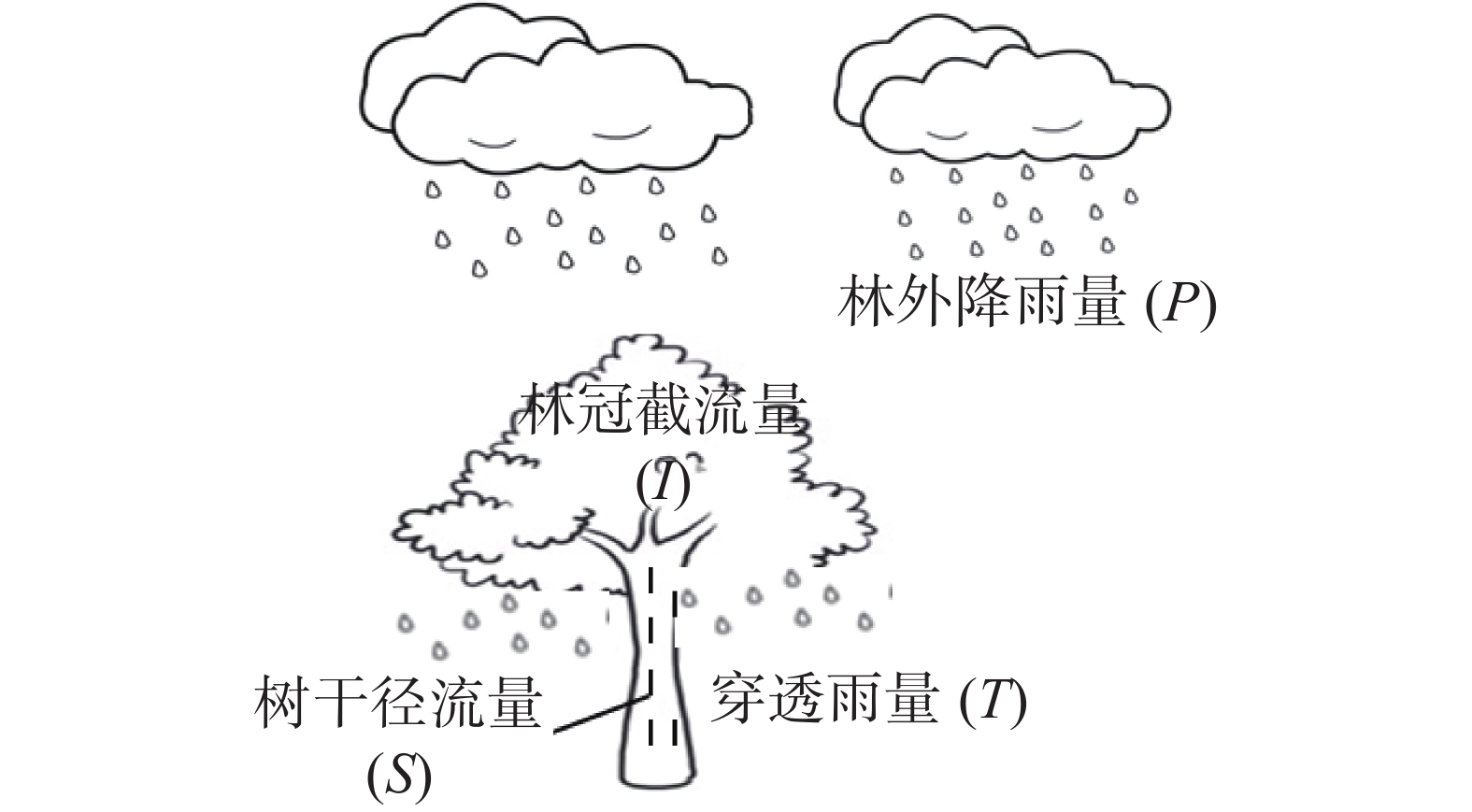

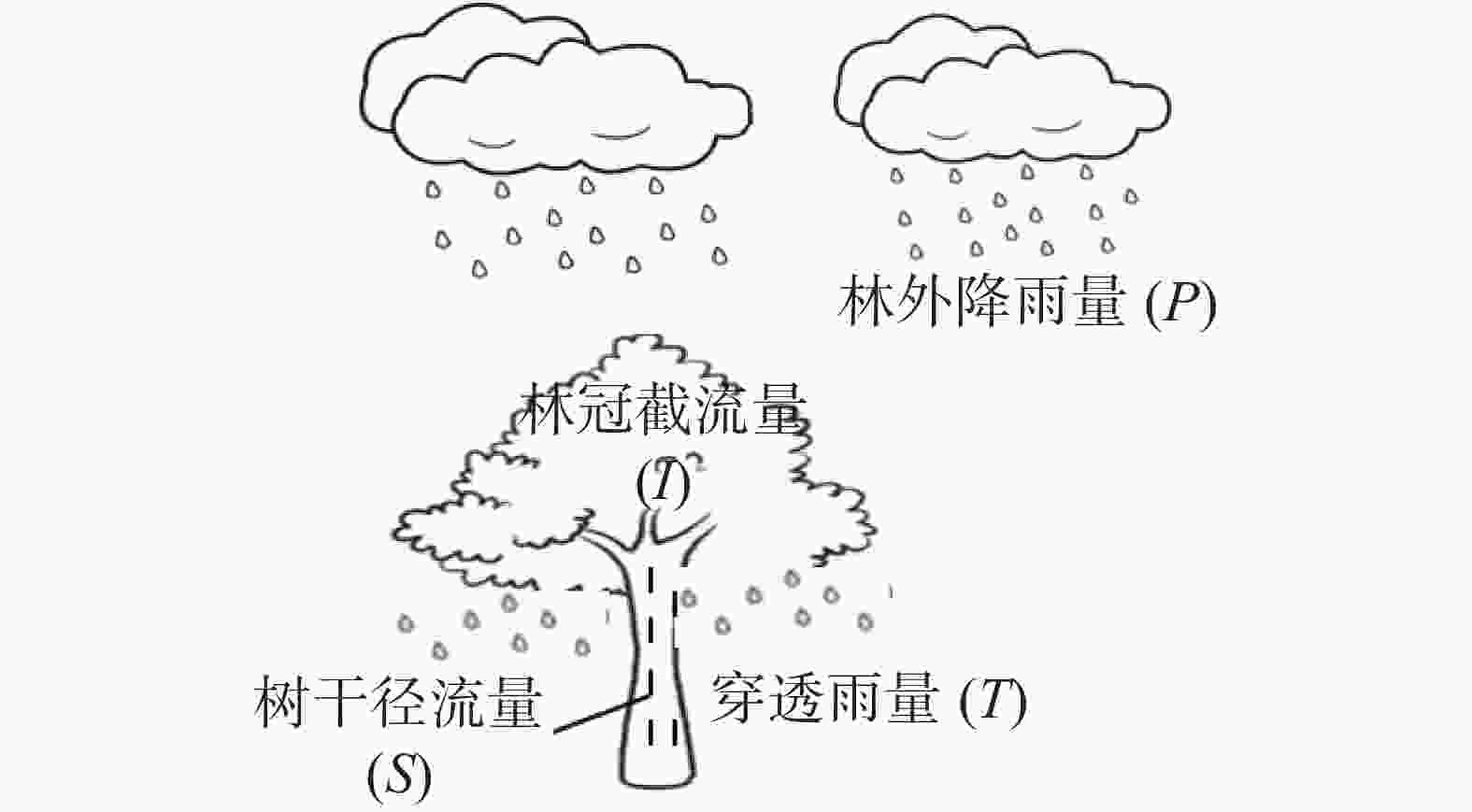


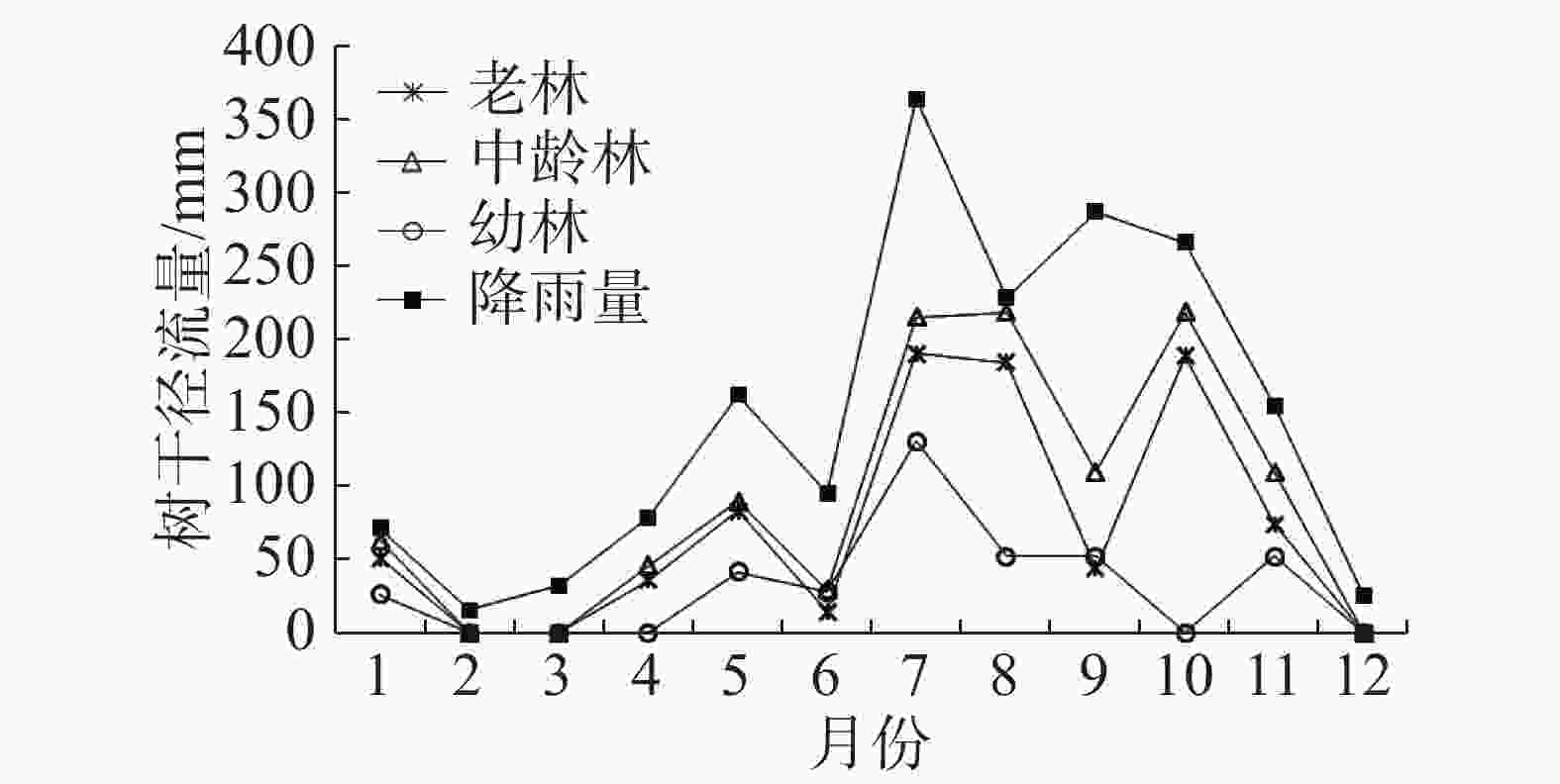
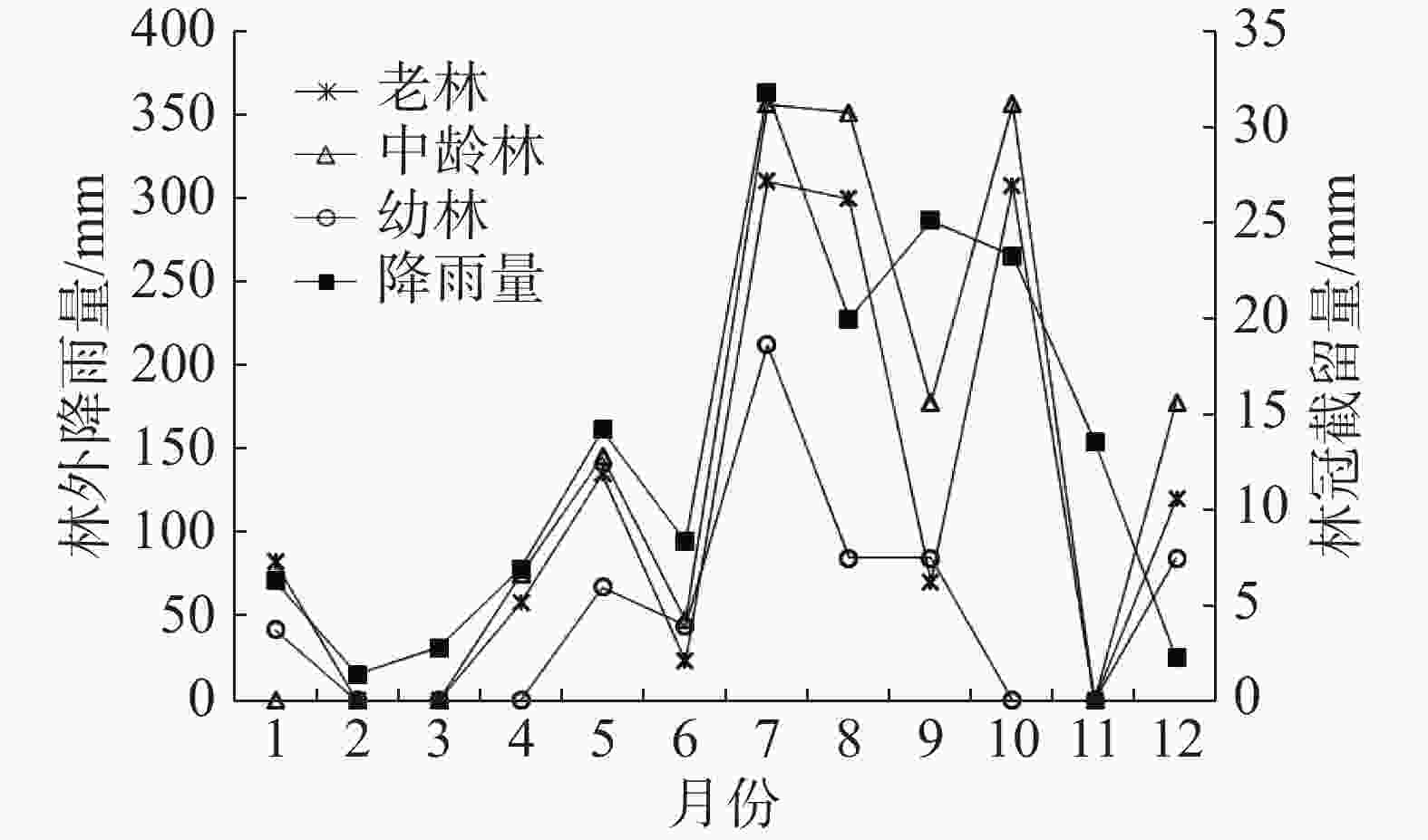
 DownLoad:
DownLoad:
